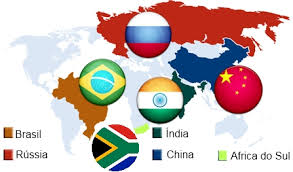BRICS: A Different Tune
Is Nero fiddling while Rome burns? As the 2014 G20 Summit drew to a close in Brisbane, world leaders voiced their determination to step up efforts to revitalise the world economy, and create more jobs. In their final communiqué, they “set an ambitious goal to lift the G20’s GDP by at least an additional two per cent by 2018.” (1) G20 leaders also promised action to increase trade, eradicate poverty, and strengthen global institutions. In addition to agreeing to “support strong and effective action to address climate change”, world leaders also reaffirmed their “longstanding and rollback commitments to resist protectionism” (2) Words such as commitment, promise and determination appear throughout the communiqué like a leitmotif, haunting and ethereal, but saying little.
 When the G20 was first formed in 1999 it became clear that all members, despite their expressed level of commitment to trade, competition and lower trade barriers, were not on the same level playing field. Developing countries have consistently asked the United States and the European Union to drop trade barriers by ending agricultural subsidies. They argue that as long as such subsidies remain in place, they can’t sell their produce in the marketplace of developed countries.
When the G20 was first formed in 1999 it became clear that all members, despite their expressed level of commitment to trade, competition and lower trade barriers, were not on the same level playing field. Developing countries have consistently asked the United States and the European Union to drop trade barriers by ending agricultural subsidies. They argue that as long as such subsidies remain in place, they can’t sell their produce in the marketplace of developed countries.
According to the CATO Institute, a Washington-based policy research institute that favours free markets and limited government intervention, the United States Department of Agriculture distributes “between $10-Billion and $30-Billion in cash subsidies to farmers and owners of farmland each year.” (3) That’s in addition to subsidised crop insurance, marketing support and other government services to farm businesses. The total in support to US farmers is between $15-Billion and $35-Billion every year. (4) The CATO Institute also says that a review of major studies by the US Congressional Budget Office in 2006 “showed that both the U.S. and global economies would gain from the repeal of subsidies and trade barriers.” (5) Despite such studies, subsidies have increased in both the U.S. and Europe.
Since the beginning of the 21st century, countries in the south, with little or no access to markets in the developed world, slowly expanded their commerce by trading among themselves. South-South trade “now exceeds North-South trade by some $2.2-Trillion – over one-quarter of global trade. (7)
In June 2009, a year after the sub-prime mortgage debacle in the United States, and its negative effect on world markets, a group of developing countries met to discuss a better way to run the world economy. The leaders of four emergent economies, Brazil, Russia, India and China (BRIC) held their first formal summit in Yekaterinburg, Russia, where they discussed how to reform financial institutions so the world economy could work better for everyone. They also talked about playing a greater part in world affairs. When the BRIC countries announced the need for a new global reserve currency, it caused a temporary drop in the value of the US dollar against other major currencies.
Two years later, South Africa joined, and the organisation became known as BRICS. In 2012, BRICS called for an alternative to the World Bank to make it less dependent on the U.S. and Europe. They agreed to study a proposal for a South-South Development Bank.
In July 2014, BRICS held its sixth summit in Fortalesa, Brazil and agreed to set up a New Development Bank. The Shanghai-based NDB will have an initial $50-Billion in capital. A Contingency Reserve Arrangement (CRA) was also set up to help countries with balance of payments problems. The Fortalesa Declaration was clear on what developing nations thought of Bretton-Woods institutions such as the IMF: “…international governance structures designed within a different power configuration show increasingly evident signs of losing legitimacy and effectiveness, as transitional and ad hoc arrangements become increasingly prevalent, often at the expense of multilateralism.” (8)
Will the world eventually see BRICS as an alternative to Bretton-Woods? Will its policies and actions result in “more representative and equitable governance”? (9) At this point, it’s not yet known what role BRICS will play, nor what influence it will have on the world economy. What is known is that BRICS has been progressively gaining influence outside the United States and Europe, and its economies are doing well. From the beginning, BRICS has focused on setting funds aside for infrastructure projects for members who, as developing nations, might be more open to dealing with the NDB than the IMF. The $800-Billion oil pipeline deal signed by BRICS members Russia and China earlier this year is the largest infrastructure project in the world, and stands as an example for future BRICS members. As the economies of developing countries expand, and such projects become more important, they will most likely favour markets that didn’t block them with trade barriers.
Though BRICS is not yet a household name, it’s sure to give the international political economy set up after the Second World War a run for its money.
Bibliography
1) G20 Summit, Brisbane, 2014, G20 Leaders Summit Communiqué, November 2014
2) Ibid
3) C. Edwards, June 2009, CATO Institute, Downsizing the Federal Government, Agricultural Subsidies
http://www.downsizinggovernment.org/agriculture/subsidies
4) Ibid
5) Ibid
6) European Commission, Agriculture and Rural Development, CAP – how much does it cost?
http://ec.europa.eu/agriculture/faq/index_en.htm#5
7) Desai R., Vreeland J. R. ,Washington Post, What the New Bank of brics is all about, July 17, 2014
8) University of Toronto, BRICS Information Centre; The 6th BRICS Summit: Fortaleza Declaration
http://www.brics.utoronto.ca/docs/140715-leaders.html
9) Ibid
Tags: BRICS, G20, Political Economy